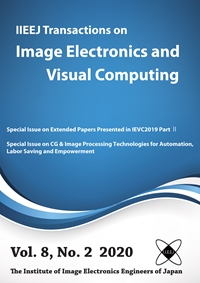Volume 8, Issue 2
IIEEJ Transactions on Image Electronics and Visual Computing
Displaying 1-5 of 5 articles from this issue
- |<
- <
- 1
- >
- >|
-
Article type: Contributed Papers-- Special Issue on Extended Papers Presented in IEVC2019 Part Ⅱ --
2020Volume 8Issue 2 Pages 79-90
Published: December 15, 2020
Released on J-STAGE: March 31, 2021
Download PDF (1619K) -
Article type: Contributed Papers-- Special Issue on Extended Papers Presented in IEVC2019 Part Ⅱ --
2020Volume 8Issue 2 Pages 91-99
Published: December 15, 2020
Released on J-STAGE: March 31, 2021
Download PDF (7486K) -
Article type: System Development Paper-- Special Issue on Extended Papers Presented in IEVC2019 Part Ⅱ--
2020Volume 8Issue 2 Pages 100-108
Published: December 15, 2020
Released on J-STAGE: March 31, 2021
Download PDF (3726K) -
Article type: Contributed Paper-- Special Issue on CG & Image Processing Technologies for Automation, Labor Saving and Empowerment --
2020Volume 8Issue 2 Pages 110-120
Published: December 15, 2020
Released on J-STAGE: March 31, 2021
Download PDF (4288K) -
Article type: Contributed Paper
2020Volume 8Issue 2 Pages 121-135
Published: December 15, 2020
Released on J-STAGE: March 31, 2021
Download PDF (5204K)
- |<
- <
- 1
- >
- >|
